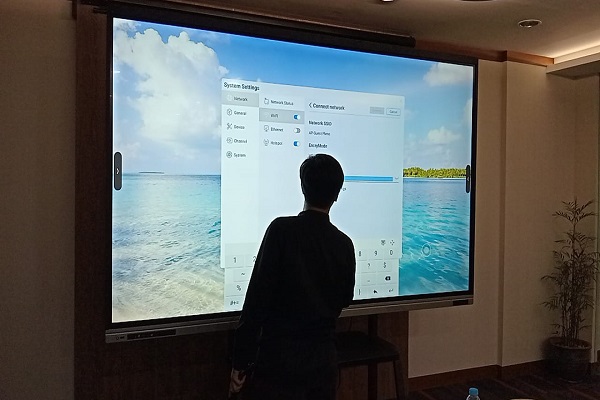Application fields and development of interactive whiteboards 2
Enhancing Business Collaboration
Beyond the classroom, interactive whiteboards are making waves in the business world. In an era where remote work and virtual meetings are becoming the norm, It can offer a powerful solution for enhancing collaboration and communication.
In boardrooms and meeting spaces, interactive whiteboards serve as a central hub for brainstorming, planning, and decision-making. Teams can use them to visualize ideas, create mind maps, and annotate documents in real-time. This collaborative approach not only streamlines the decision-making process but also ensures that all team members are on the same page.
For businesses with remote teams, interactive whiteboards can be a game-changer. Many interactive whiteboards come equipped with video conferencing capabilities, allowing team members to join meetings from anywhere in the world. They can share their screens, contribute to discussions, and even work on the same document simultaneously. This level of interactivity bridges the gap between in-person and remote collaboration, fostering a sense of unity and productivity.
Furthermore, interactive whiteboards are being used in training and development programs. Companies can create interactive training modules that engage employees and provide immediate feedback. This not only enhances the learning experience but also ensures that employees retain the information more effectively.
As with any technology, they continue to evolve, driven by advancements in hardware and software. One of the most notable trends is the integration of artificial intelligence (AI) and machine learning. These technologies enable interactive whiteboards to offer personalized experiences, such as adaptive learning paths for students or intelligent suggestions during business meetings.
Another challenge is the learning curve associated with using it. While they are designed to be user-friendly, some teachers and professionals may require training to fully utilize their features. Providing adequate training and support is crucial to ensuring that users can make the most of these tools.
Moreover, there is the issue of maintenance and technical support. Like any electronic device, interactive whiteboards can experience technical difficulties. Schools and businesses need to have a plan in place for troubleshooting and repairs to minimize downtime.
Interactive whiteboards have undoubtedly revolutionized the way we teach, learn, and collaborate. Their ability to combine the simplicity of traditional whiteboards with the power of digital technology has made them an invaluable tool in both education and business. As technology continues to advance, we can expect interactive whiteboards to become even more sophisticated, offering new and exciting possibilities for interaction and collaboration.
While challenges such as cost and the learning curve remain, the benefits of interactive whiteboards far outweigh the drawbacks. By investing in these tools and providing the necessary training and support, schools and businesses can unlock their full potential, creating a more engaging, interactive, and productive environment for all.
In a world where technology is constantly changing, interactive whiteboards stand out as a shining example of how innovation can enhance our lives. Whether in the classroom or the boardroom, these devices are paving the way for a brighter, more connected future.

